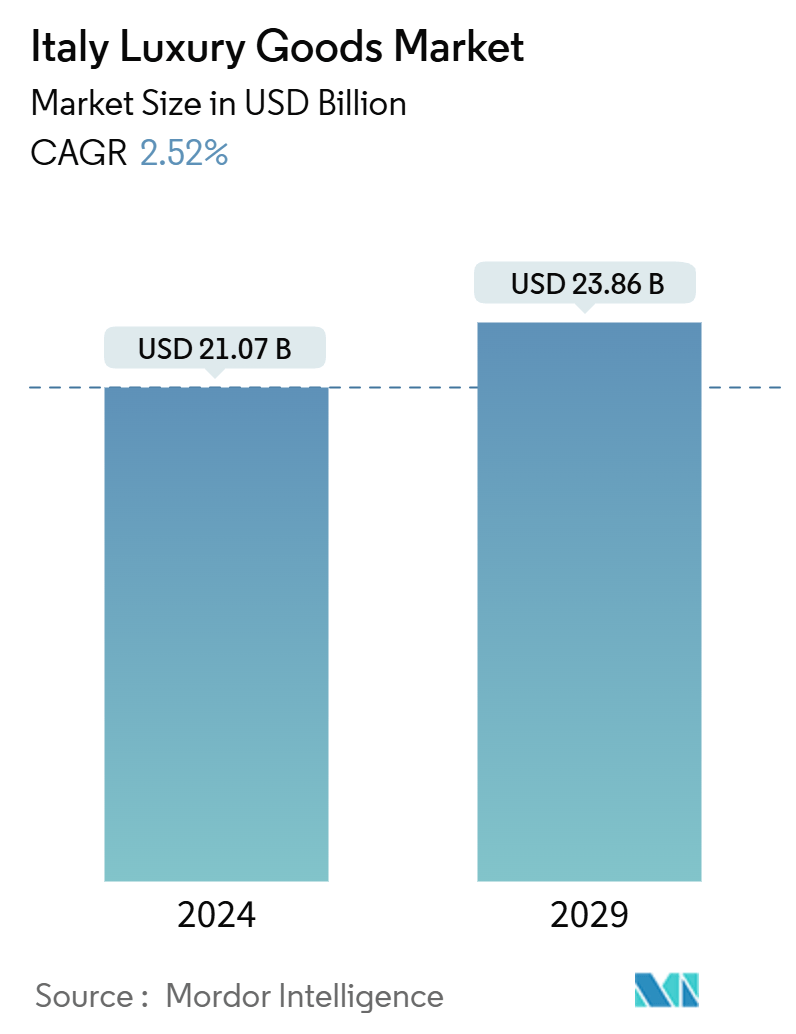Market Size of Italy Luxury Goods Industry

| Study Period | 2019 - 2029 |
| Base Year For Estimation | 2023 |
| Market Size (2024) | USD 21.07 Billion |
| Market Size (2029) | USD 23.86 Billion |
| CAGR (2024 - 2029) | 2.52 % |
| Market Concentration | Low |
Major Players.webp)
*Disclaimer: Major Players sorted in no particular order |
Italy Luxury Goods Market Analysis
The Italy Luxury Goods Market size is estimated at USD 21.07 billion in 2024, and is expected to reach USD 23.86 billion by 2029, at a CAGR of 2.52% during the forecast period (2024-2029).
In Italy, rising disposable incomes and heightened spending on clothing, fueled by the sway of social media fashion trends, are driving a surge in purchases of premium and high-end luxury goods. For instance, data from the Organization for Economic Co-operation and Development (OECD) highlights that Italian households spent EUR 65,601.0 million on clothing and footwear in 2023, up from EUR 55,288.8 million in 2021. Luxury brands are increasingly teaming up with artists, designers, and celebrities to roll out limited-edition collections. For instance, in June 2023, Prada, the renowned Italian luxury fashion house, unveiled its global campaign "The Glass Age" in collaboration with the globally acclaimed actress Scarlett Johansson. The campaign prominently featured the iconic Prada Galleria handbag, with Da Corte artistically reinterpreting Johansson's image through color to encapsulate the campaign's essence. Such collaborations not only draw in new customers but also amplify brand reach and stir excitement around products. Furthermore, Italian consumers are now demanding sustainability and transparency from luxury brands. There is an intensified emphasis on ethical manufacturing, responsible sourcing, and eco-friendly materials. This shift is compelling luxury manufacturers to weave sustainable practices into their brand ethos. Moreover, the Italian luxury goods landscape is marked by companies striving for innovation and geographical expansion to carve out a competitive edge. Highlighting this trend, in February 2024, Ermenegildo Zegna Group unveiled plans for a new luxury footwear and leather goods facility in Sala Baganza, Italy, underscoring its commitment to bolstering production capacity and championing Italian craftsmanship.
Italy Luxury Goods Industry Segmentation
Luxury products typically come with a higher price tag, catering predominantly to individuals with above-average disposable incomes or substantial acquired wealth.
The Italian luxury goods market is categorized by product types and distribution channels. In terms of product types, the market encompasses clothing and apparel, footwear, bags, jewelry, watches, and various other accessories. Regarding distribution channels, the market is divided among single-brand stores, multi-brand outlets, and online platforms.
Market sizing is presented in USD value terms for all segments mentioned above.
| By Type | |
| Clothing and Apparel | |
| Footwear | |
| Bags | |
| Jewelry | |
| Watches | |
| Other Accessories |
| By Distibution Channel | |
| Single-brand Stores | |
| Multi-brand Stores | |
| Online Stores |
Italy Luxury Goods Market Size Summary
The Italy luxury goods market is poised for growth, driven by the expansion of e-commerce and the increasing number of luxury brand boutiques. The COVID-19 pandemic initially disrupted sales due to travel restrictions, impacting both demand and supply chains. However, it also accelerated the shift towards digital platforms, with brands enhancing their online presence to compensate for the decline in physical store sales. The market is characterized by a strong demand for luxury leather goods, with Italy being a significant player in this segment. Renowned brands like Bottega Veneta, Furla, and Fendi dominate the market, particularly in footwear and leather bags, which are among the most sought-after luxury items.
The competitive landscape of the Italian luxury goods market is marked by the presence of globally recognized home-grown brands such as LVMH, Kering, and Prada. These companies are leveraging both traditional and digital media for marketing, with a notable emphasis on social media and celebrity endorsements to enhance brand visibility and appeal. The market's growth is further supported by strategic investments in retail expansion and digital transformation, allowing brands to reach a broader audience. Ethical manufacturing and sustainable practices are also becoming increasingly important as brands strive to maintain a competitive edge in this dynamic market.
Italy Luxury Goods Market Size - Table of Contents
-
1. MARKET DYNAMICS
-
1.1 Market Drivers
-
1.1.1 Italian Craftmanship In Luxury Goods Being Perceived As A Status Symbol
-
1.1.2 Strong Influence Of Social Media And Aggressive Marketing
-
-
1.2 Market Restraints
-
1.2.1 Counterfeiting Posing A Threat To The Market Growth
-
-
1.3 Porter's Five Force Analysis
-
1.3.1 Threat of New Entrants
-
1.3.2 Bargaining Power of Buyers/Consumers
-
1.3.3 Bargaining Power of Suppliers
-
1.3.4 Threat of Substitute Products
-
1.3.5 Intensity of Competitive Rivalry
-
-
-
2. MARKET SEGMENTATION
-
2.1 By Type
-
2.1.1 Clothing and Apparel
-
2.1.2 Footwear
-
2.1.3 Bags
-
2.1.4 Jewelry
-
2.1.5 Watches
-
2.1.6 Other Accessories
-
-
2.2 By Distibution Channel
-
2.2.1 Single-brand Stores
-
2.2.2 Multi-brand Stores
-
2.2.3 Online Stores
-
-
Italy Luxury Goods Market Size FAQs
How big is the Italy Luxury Goods Market?
The Italy Luxury Goods Market size is expected to reach USD 21.07 billion in 2024 and grow at a CAGR of 2.52% to reach USD 23.86 billion by 2029.
What is the current Italy Luxury Goods Market size?
In 2024, the Italy Luxury Goods Market size is expected to reach USD 21.07 billion.

